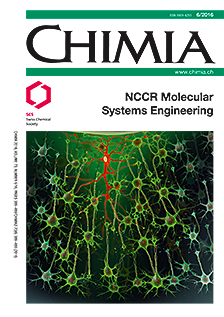Artificial Organelles: Reactions inside Protein–Polymer Supramolecular Assemblies
DOI:
https://doi.org/10.2533/chimia.2016.424Keywords:
Amphiphilic copolymers, Artificial organelles, Enzymatic reactions, NanoreactorsAbstract
Reactions inside confined compartments at the nanoscale represent an essential step in the development of complex multifunctional systems to serve as molecular factories. In this respect, the biomimetic approach of combining biomolecules (proteins, enzymes, mimics) with synthetic membranes is an elegant way to create functional nanoreactors, or even simple artificial organelles, that function inside cells after uptake. Functionality is provided by the specificity of the biomolecule(s), whilst the synthetic compartment provides mechanical stability and robustness. The availability of a large variety of biomolecules and synthetic membranes allows the properties and functionality of these reaction spaces to be tailored and adjusted for building complex self-organized systems as the basis for molecular factories.Downloads
Published
2016-06-29
Issue
Section
Scientific Articles
License
Copyright (c) 2016 Swiss Chemical Society

This work is licensed under a Creative Commons Attribution-NonCommercial 4.0 International License.
How to Cite
[1]
M. Garni, T. Einfalt, M. Lomora, A. Car, W. Meier, C. G. Palivan, Chimia 2016, 70, 424, DOI: 10.2533/chimia.2016.424.







